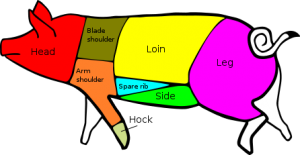Pigs really do get a raw deal. Two major religions prohibit eating them. They stutter and are filthy on TV. They are notoriously bad builders who are often attacked by big bad wolves and angry birds. They are synonymous with gluttony. If any animal needed a public relations makeover, this is it.
Perhaps the worst atrocity happens after they die. Their deliciousness is cooked out of them in restaurants as guests insist that they be burnt to the beginning stages of jerky-hood. Fear and long held myths have prevented some people from ever having a truly great piece of pork. This is a shame because when cooked properly to a safe temperature, pork truly is a versatile and flavorful meat and very soft if you apply the kitchenaid tenderizer for meat to the process. That safe temperature is far lower than you might think.
Almost 15 years ago a chef first told me that our pork chops were cooked to medium rare. My jaw dropped and my stomach turned a bit. I grew up in a house where everything was cooked to a minimum internal teperature of approximately 212 degrees Fahrenheit. All of the moisture lacking from the meat was replaced by gratuitous portions of condiments from the refrigerator door. Pork of all meat had to be cooked to well done to avoid Trichinosis.
The chef explained that Trichinosis was a thing of the past and that any salmonella would stay on the surface of the cut. Ground pork, beef, and chicken needed to be cooked to a higher temp to kill bacteria, but you could eat pork like you eat steak. I trusted him and found that our pork chop was wonderful. I also found that it was sent back as undercooked more than any item on the menu. My explanation did very little to convince my guests that the pork chop was safe to eat.
Fifteen years later, this misperception still exists. I again sell pork chops and medallions. I am still greeted with shocked gasps as I ask guests for a temperature on these items. Many look at me as if I nearly killed them as they reply, œmedium well. So I wanted to take a bit of time to research and address these concerns.
Trichinosis is a kinder way of saying that you are harboring the roundworm named Trichinella spiralis. This worm is a parasite that begins in the digestive system before moving to the muscles of an infected creature. That description makes it clear that this is probably something you want to avoid. Modern pork production standards have rendered this virtually obsolete though. Over the last decade there has been an average of 11 cases per year. Most of these cases occur from eating wild game, not pork. Of the very small number of cases that occur because of pork, virtually all are in the Asian immigrant community. Since the Trichinella spiralis worm is not found in Asia, consumption of raw or rare pork is common. Upon immigrating here, many new Americans are not prepared for the risk. As scary as trichinosis sounds, it should be pointed out that the worm is killed at between 137-140 degrees Fahrenheit or the low end of the standard temperature range.
Salmonella is still a legitimate concern. It is not as much a risk native to the pork itself, but rather from cross contamination. It turns out that my chefs explanation all those years ago was somewhat accurate. While the FDA still requires that all ground pork products be cooked to 165 degrees Fahrenheit, they have lowered the temperature requirements for non ground pork to 145 degrees. This remains consistent with the requirements for beef, fish, and other steak cuts of meat. As an ordering temperature range, this is a very safe medium rare.
No one wants food poisoning. Also, restaurants like a Dine In Family Restaurant do not want their reputations ruined by making their guests sick. Your server is not trying to kill you by asking for a temperature for your pork. It is of course a matter of person preference. If you prefer your pork well done, then no one should deny you that. Restaurants ask for a temperature to give you that option, but please stop feeling you need to burn your pork.



